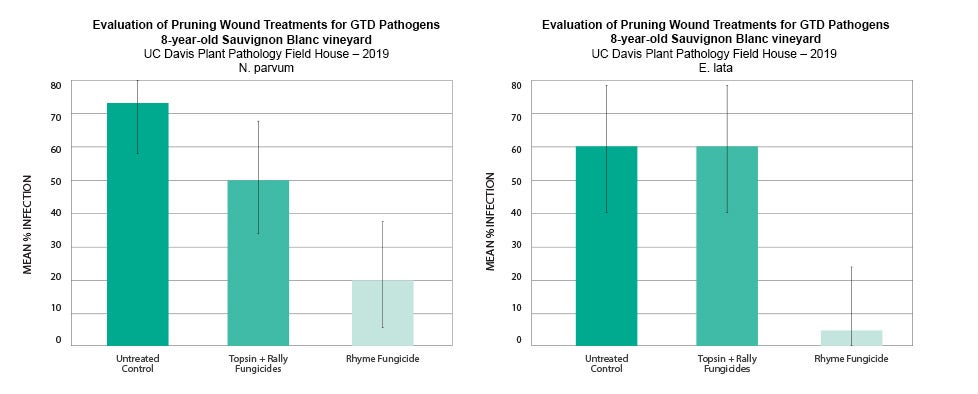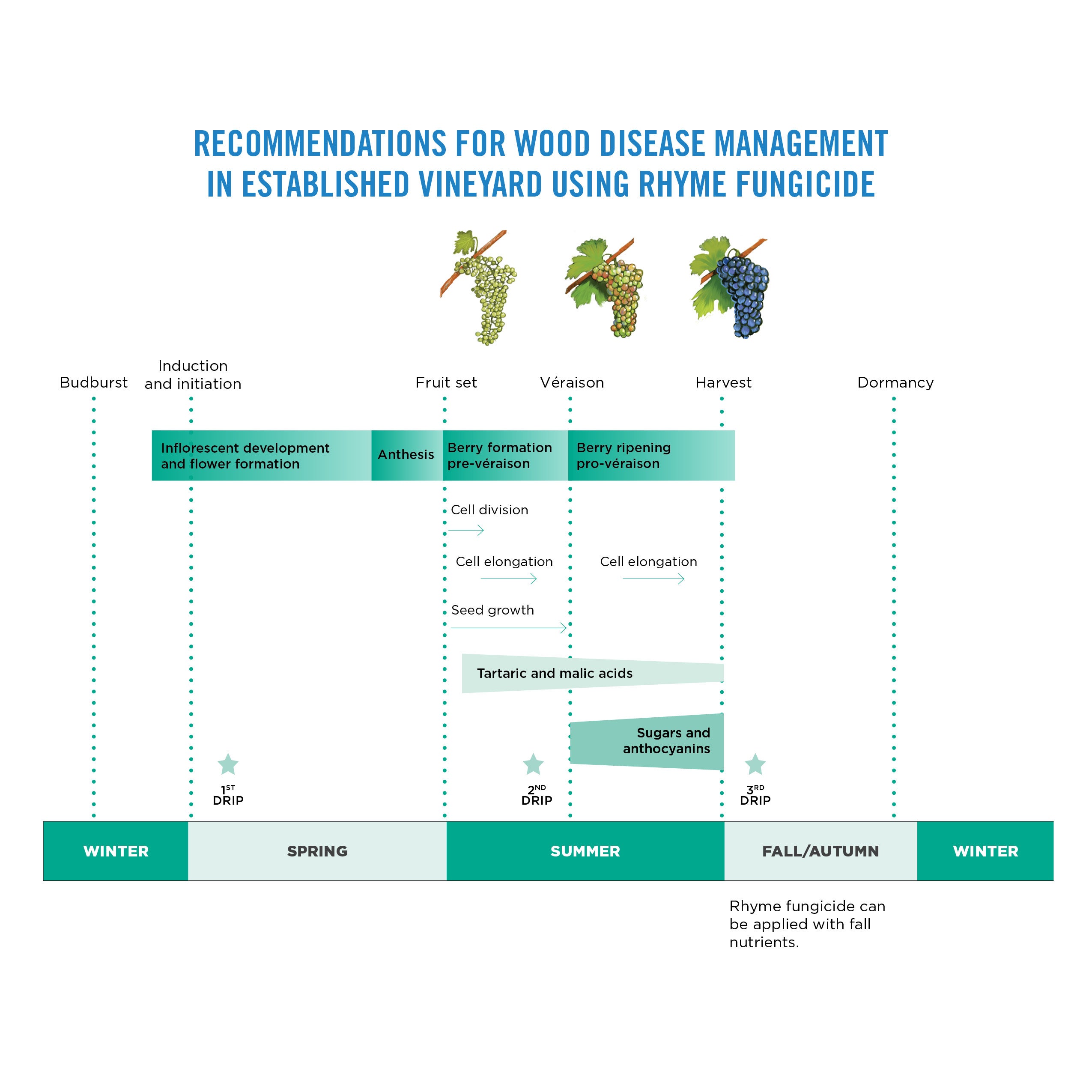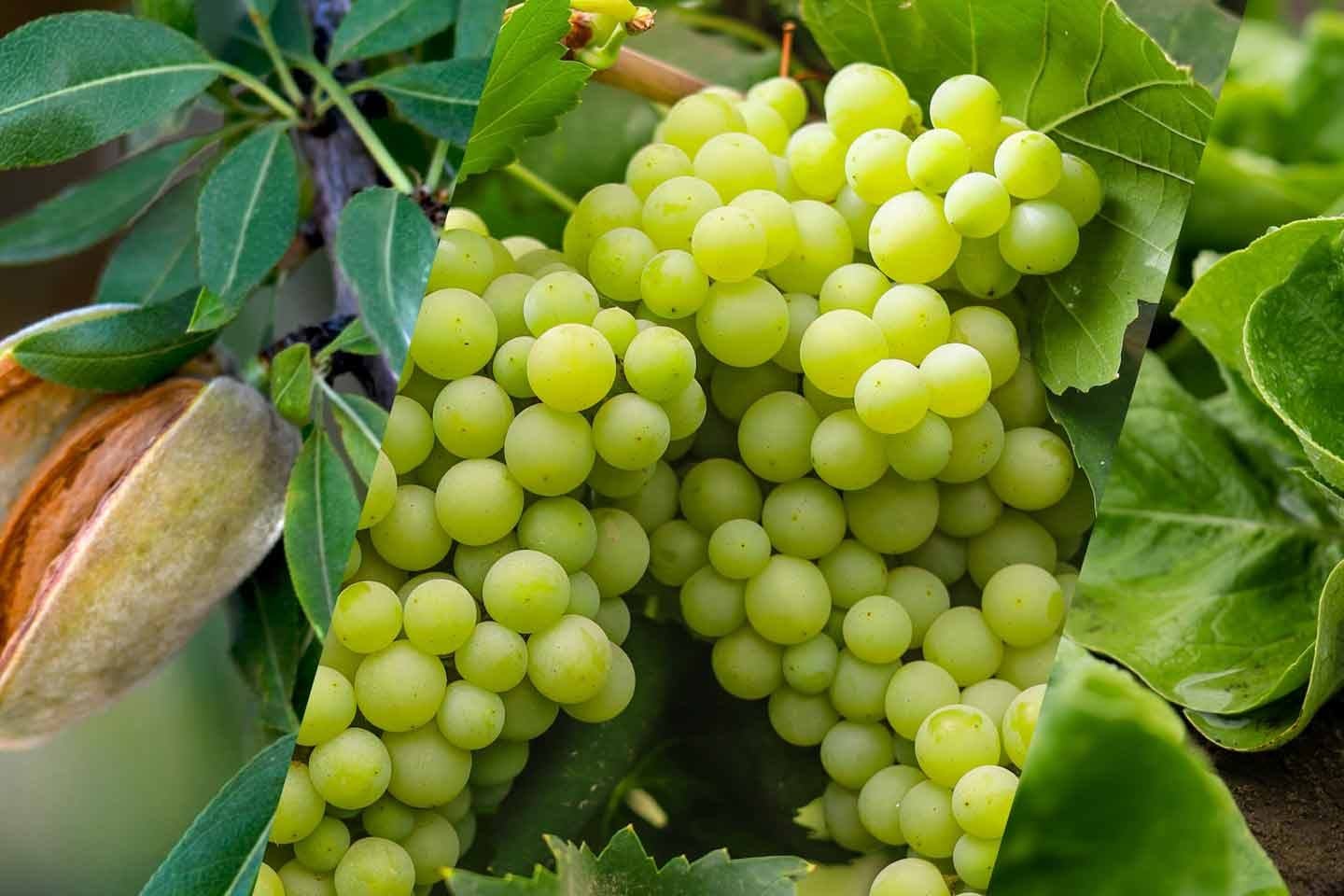Download this entire article as a PDF
Rhyme® fungicide applied via drip demonstrates efficacy on wood disease pathogens
The future economic stability of table and wine grapes is being endangered by a major threat: grapevine trunk diseases (GTDs). Today, more than 80% of California’s vineyards are impacted by GTDs with yield losses reaching upwards of 94% in severely symptomatic vineyards.*
Though this paints a bleak picture, there is a promising new tactic for managing the multiple pathogens that cause GTDs: Rhyme® fungicide from FMC. Research trials by UC Davis and FMC have documented that Rhyme fungicide applied through drip irrigation during the spring and fall root flush reduces infections from a complex of GTD pathogens, which destroy the vital xylem tissue that delivers water and nutrients to the grapevine.
FMC research trials conducted in Lodi, California, in 2018 established that Rhyme fungicide applied via drip provided equivalent or superior control of Botryosphaeria and Phomopsis compared to a mixture of Rally® fungicide plus Topsin® M fungicide sprayed on pruning wounds.
In 2019, a UC-Davis randomized pruning wound protectant trial in an 8-year-old Sauvignon Blanc vineyard found applying Rhyme fungicide via drip once during the early spring root flush and once after harvest during the fall root flush significantly reduced the mean percent infection rate for two of the most common and aggressive GTD pathogens, Eutypa lata (E. lata) and Neofusicoccum parvum (N. parvum), compared to the untreated check. Additionally, the Rhyme fungicide treatment protocol performed as well as or better than the standard spray treatment of Rally fungicide plus Topsin M fungicide with organosilicone following pruning.
The UC-Davis trial results showed:
- The mean percent infection rate for N. parvum was 75% for the untreated control, 50% for the Rally fungicide plus Topsin fungicide mixture and 20% for the Rhyme fungicide drip treatment.
- The mean percent infection rate for E. lata was 60% for both the untreated control and the Rally fungicide plus Topsin fungicide treatment while it was just 5% for the Rhyme fungicide drip treatment.

NEW INTERVENTION SIMPLIFIES MANAGEMENT OF PERSISTENT AND DESTRUCTIVE PATHOGENS
Following precipitation events, GTD-causing fungal spores become airborne and colonize exposed wood vessels caused by pruning. Total disease control is virtually unattainable because of the large number of wounds made on an individual grapevine and the extended period of wound susceptibility.
“Grapevine trunk disease fungal pathogens are widespread, have many hosts and threaten all vineyards. If you don’t manage the pathogens, you lose part or all of the grapevine, so there is great long-term economic damage to the vineyard,” says Dr. Akif Eskalen, University of California Cooperative Extension plant pathologist.

The application of Rhyme fungicide via drip irrigation represents a new tactic to mitigate GTDs, made possible by the unique xylem-mobile properties of its active ingredient, flutriafol. “Rhyme fungicide is the most xylem-mobile fungicide on the market, traveling the same pathway that harbors the trunk disease pathogens,” explains Issa Qandah, FMC technical service manager in California.
Rhyme fungicide is also the only fungicide applied via drip irrigation to decrease the infection of two of the costliest diseases in grapes: powdery mildew and GTDs. “Applying Rhyme fungicide via drip at root flush in the spring and fall maximizes wood disease management and ensures protection prior to pruning while providing early powdery mildew protection,” Qandah explains. “When you have pathogens in the vine attacking the vascular system, it reduces your returns and the longevity of your vineyard,” he says. “The simplicity of applying Rhyme through the drip for key grapevine trunk disease pathogens gives vineyard managers great peace of mind.”
Still considered a novel and burgeoning practice, it is gaining traction with California PCAs and vineyard managers. Joel Noah, a PCA with Nutrien Ag Solutions, has been conducting trials with Rhyme fungicide via drip for GTDs for three years. “We’ve seen a reduction in infection compared to the untreated checks, and each year we have observed increased growth, vigor and improved yields,” he says.
This year, a dozen of Noah’s clients managed GTDs with Rhyme fungicide via drip.
“The advantage of Rhyme fungicide is its systemic movement up the xylem to new growth, which means we can treat the disease from the inside out,” Noah explains. “Prior to Rhyme fungicide, our only option was cutting the disease out, removing the wood and replacing vines. That’s expensive and labor intensive. Rhyme fungicide helps vineyards stay healthier, produce longer and more consistently over their lifespans with much less labor and application expense.”
APPLICATION TIMING IS KEY FOR MANAGING GTD VIA DRIP
Apply Rhyme fungicide to the root zone when the plant is still actively taking up water and nutrients. This allows the active ingredient in Rhyme fungicide to translocate from the soil through the plant via the xylem. There are three windows for application: spring root flush, before veraison and fall root flush.
-
For young vineyards 3-6 years of age, Rhyme fungicide should be applied via drip twice: once after harvest during the fall root flush and once during the spring root flush when new growth is at 4-8 inches.
-
In older vineyards where GTDs are well established in the vascular system, three drip applications are recommended: one at spring root flush, one mid-season before veraison and during fall root flush after harvest.

*Akif Eskalen-UC Davis
This Rhyme fungicide recommendation is made as permitted under FIFRA Section 2(ee) for the management of wood disease complex on grapes in California. This recommendation has not been submitted to or approved by the EPA. The 2(ee) expiration date is 12/05/2024.
Always read and follow all label directions, precautions and restrictions for use. Some products may not be registered for sale or use in all states. FMC, the FMC logo and Rhyme are trademarks of FMC Corporation or an affiliate. Rally is a trademark of Dow AgroSciences, DuPont or Pioneer and their affiliated companies or their respecive owners. Topsin is a trademark of Nippon Soda Company, Ltd. ©2020 FMC Corporation. All rights reserved. 20-FMC-0815 10/20



